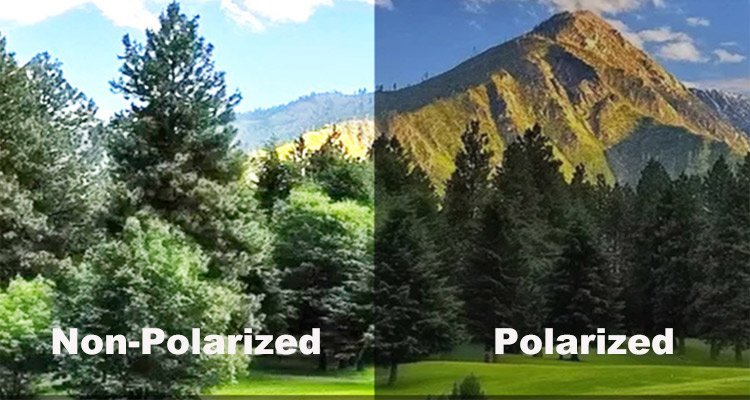Are you going out for a trip, hiking, or camping? While searching for your outfit-of-the-day (OOTD), you also need a pair of good sunglasses. Between polarized vs. non-polarized, how would you know which one you should pick?
Polarized sunglasses have lenses with a polarizing filter. It offers advanced anti-glare and anti-reflection protection against harmful UVA and UVB rays. Moreover, you can have a brighter and more precise vision while wearing it. While non-polarized lenses can lessen the amount of light, it is not enough to make the image crisp.
Choosing the right kind of sunglasses can be challenging. Aside from the design, you also have to consider its protection. With the changing climate, the sun’s UV rays are getting more intense. Hence, you have to ensure that you are getting proper protection. If you still feel confused after a handful of options, keep on reading. I will give you the differences between polarized and non-polarized sunglasses.
How do Polarized & Non-Polarized Lenses work?
Suppose you want to get the right protection for your eyes whenever you’re outdoors. In that case, you need to understand how polarized and non-polarized lenses work first.
Our eyes perceive light through waves (light waves). Waves that vibrate in more than one plane is what experts call ‘unpolarized light.’ Meanwhile, polarized light waves have vibrations that happen in a single plane. The light can travel in both vertical and horizontal directions. Remember that horizontal light is more problematic for you. It’s because it can create dangerous glare as it bounds on different surfaces.
The direction of light is a key distinction in choosing the right pair of sunglasses. Both lenses have protection against UVA and UVB rays. But, only polarized sunglasses have a polarizing filter that can transform light waves. Hence, it gives you protection against dangerous horizontal light.
Once the light hits the lens, the polarizing filter sends back the light to another direction. As a result, it offers advanced anti-glare and anti-reflection protection. Hence, it becomes less disturbing to your vision. Non-polarized lenses don’t filter the harmful light this way, so the glare is more evident. It makes it more difficult to see where there is too much sunlight.

Comparing Polarized & Non-Polarized Sunglasses
It is interesting to see which is better between polarized sunlgasses and non-polarized sunglasses. It’s because, although there some distinction, these have lenses that have different functions. With the extra polarizing filters, you’d think that polarized sunglasses are better. I hate to break it up to you, but it is not always the case. There are some situations wherein polarized are better over non-polarized and vise versa.
Lenses Used
Polarized lenses can protect you against destructive UVA and UVB rays. It also filters light in a horizontal orientation, the most harmful light direction. Without proper protection, light can cause glare. It can range from unnoticeable, irritating to blinding, depending on your eyes’ sensitivity.
Non-polarized lenses also provide UVA and UVB protection as well. Moreover, it reduces the brightness of all kinds of light. Yet, it can’t help you with the glare since it has no polarizing filters. The primary role of non-polarized lenses is to reduce the amount of light that can reach your eyes. It can help you, but it’s not the answer to all your Sunwear woes.
I wouldn’t say that there is a clear winner between polarized vs. non-polarized lenses. It is because they offer solutions for different situations.
Glare Protection
Manufacturers create polarized sunglasses for reducing glare. The glare that the sun rays generate can be annoying and dangerous at the same time in some situations. Polarized sunglasses ensures that you can see images while walking under the sun.
Clear Vision
Polarized lenses can cut out the glare. As a result, it can help you see better outside and have a clearer vision. But, if you would be looking and reading LCDs, non-polarized is a better option. Why?
Most LCDs, like those that you have on your smartphones, already have a polarizing filter. It lets you see the screen better even in bright sunlight. It is also the job of polarized sunglasses, which only means that the two will only cancel each other out. As a result, your LCD screen may appear darker or completely black when you look at it. This case is true for most pilots. It’s why they don’t use polarized sunglasses when maneuvering a plane.
When Is The Right Time To Wear Polarized Or Non-Polarized Sunglasses?
Both polarized and non-polarized sunglasses offer benefits that make them worth the buy. You need to identify the circumstances where and when you will wear sunglasses. This way, you’ll know which one between them is better. So, it all boils down to knowing your purpose in buying a pair of sunglasses.

When Should You Wear Polarized Sunglasses?
Here are some situations when polarized sunglasses are a better option to wear.
- Driving a Car. When driving your vehicle, always use polarized sunglasses. It’s because its lenses can help you cut out any glare that may be dangerous. Sometimes, your car’s sunshade and tint are not enough to give you proper protection. It’s true, especially on a bright and sunny day.
- Fishing. Glare can reflect off the water’s surface. So, polarized sunglasses are better used when fishing and other activities involving water. You don’t want to miss that catch, do you?
- Biking. Polarized sunglasses can help you prevent various harmful glare. It can be distracting and a threat to others.
- Walking Around. Even walking around under the sun may allow you to wear polarized sunglasses. It’s because glare can be anywhere.
When Should You Wear Non-Polarized Sunglasses?
As mentioned, polarized sunglasses are like an improved version of non-polarized sunglasses.
- Skiing. When you plan on skiing, you might need non-polarized sunglasses over its counterpart. Why? It’s because glare can help in distinguishing the snow from ice. Thus, you can see where to go and avoid any hazardous situations.
- Flying. If you are a pilot, you need to wear non-polarized sunglasses while flying. It will help you look and read the controls and GPS in the cockpit better. These controls on the LCD are already polarized. Avoid wearing polarized sunglasses so that they don’t cancel out each other.
- Operating Heavy Machinery. If your work involves operating heavy machinery, non-polarized sunglasses are better to use. It can be impossible to see the controls or GPS displays used in these cases with some polarized lenses.
Final Thoughts On Polarized & Non-Polarized
Both polarized and non-polarized sunglasses will give you protection against harmful UV rays. Polarized lenses will remove any discomfort caused by intense sources of light. This way, you can have extra to see colors or contours. It’s clear that you wouldn’t even notice any differences even without sunglasses. Meanwhile, non-polarized lenses are more efficient when reading digital screens or displays.
In the end, it’s all about making the right choices for different situations. Polarized lenses can reduce eye strain. Moreover, it can reduce reflection that can enter your eyes. As a result, you can have enhanced vision even when the amount of sunlight is overwhelming. A pair of non-polarized sunglasses can give your eyes UV protection during a cloudy day.



